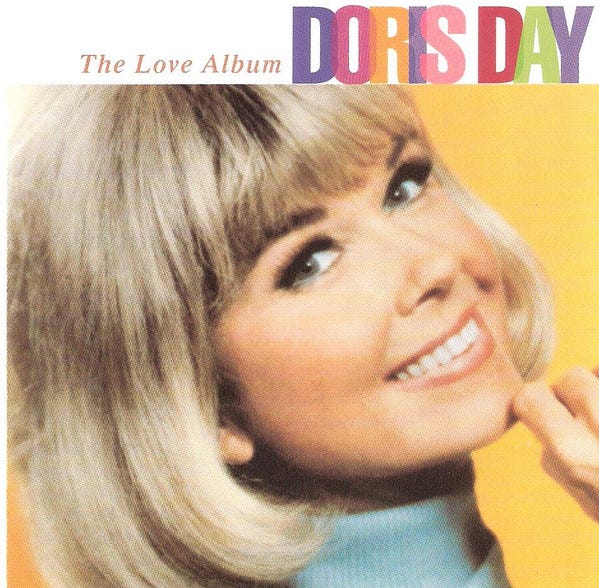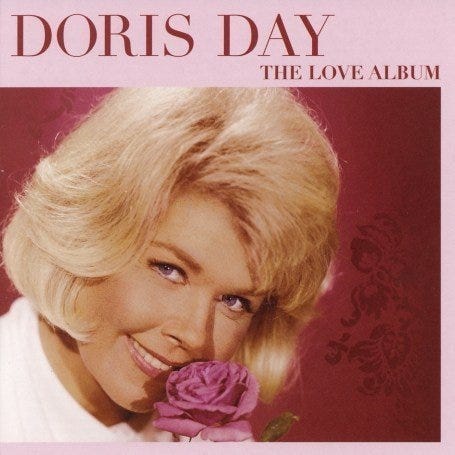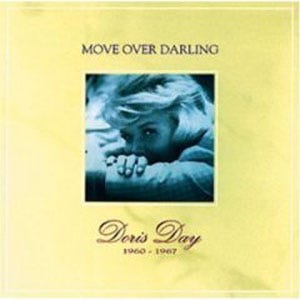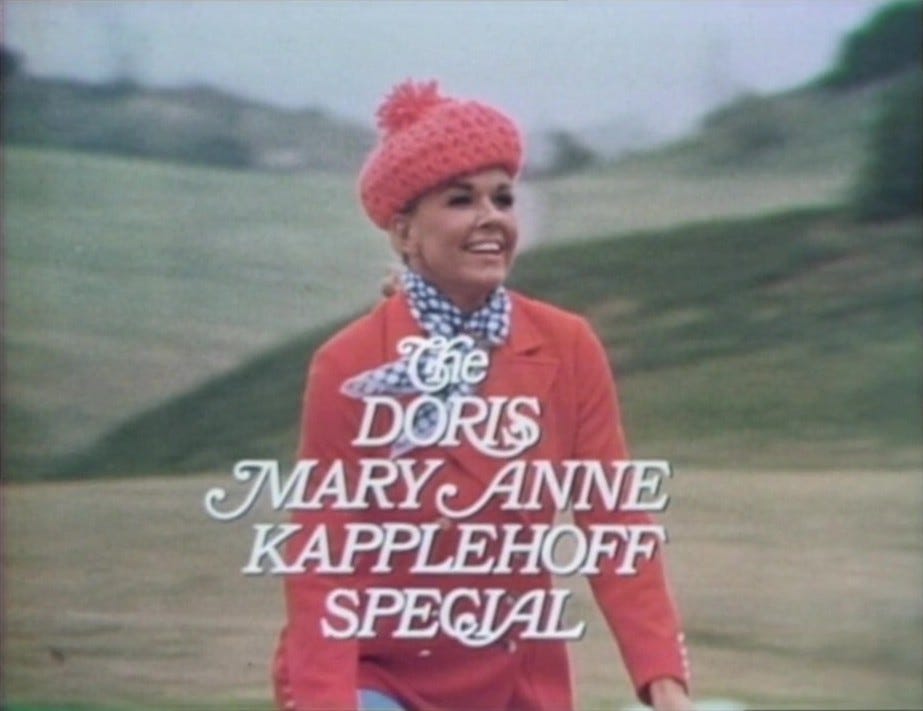A DATE WITH DORIS, PART 1: THE LOVE ALBUM
And Don't Miss A Tribute to Doris Day - Wednesday October 18 at Rose Hall
This is a special moment for Doris Day fans! On Wednesday, October 18, at Rose Hall, Jazz at Lincoln Center, the Mabel Mercer Foundation will present Sentimental Journey: A Tribute to Doris Day, produced and hosted by the Great Lady’s great friend, the internationally celebrated film critic and journalist Rex Reed. In honor of the occasion, I’m also doing a new essay on Doris for The New York Sun, and a special episode of Sing! Sing! Sing! on KSDS San Diego (I’ll provide info on how to listen to it below) which will include a new interview with Rex as well as one of my vintage interviews with Doris herself.
I wrote these notes in 2005 for the American release of what became one of her most celebrated - as well as final - albums, The Love Album, tracks that were actually taped many years earlier in 1967. I thought it would be informative to reproduce those notes here. Special thanks to Jim Pierson for, among many other things, recruiting me to write this essay to begin with.
Here’s a rough chronology of the album - provided by Jim:
1967 - Doris Day records the basic 12 tracks, all romantic ballads, with the arranger and conductor Sid Feller. For whatever reason, Columbia Records does not issue them at the time.
1994 - the tracks are released as The Love Album in the UK and Australia. (There’s another UK release, apparently from 1997, titled With Love, with a different cover.)
1997 - the tracks are included in Move Over Darling, the fourth and final of the big Bear Family collections of Doris’s recordings, produced and released in Germany (javol!).
2006 - The Love Album is released in the USA, thanks to Jim Pierson and Michael Feinstein. Three tracks from Doris’s 1971 TV special are included as bonuses, for a total of 15. There is new artwork and notes (mine).
2016 - The Love Album is reissued with new art - I believe my notes are still in there, but I don’t know for certain.
2020 - The Love Album is released (minus the bonus tracks) for the first time as a vinyl LP.
So here’s the notes, vintage Wilsci 2005 (thanks again to Elizabeth Zimmer for proofing!)
The Love Album - All 15 Tracks YouTube playlist
DORIS DAY – The Love Album (Special Edition)
It’s only fitting that Doris Day should sing “Sentimental Journey” at the end of her 1971 television production, The Doris Mary Anne Kappelhoff Special. After all, the song, which she first recorded back when she was the girl singer with Les Brown, was her first big hit. Day and “Sentimental Journey” put each other on the map, as it were – that was so early that the group was still known as “Les Brown and his Orchestra” and was far from being rechristened “His Band of Renown.” “Sentimental Journey” had a very specific meaning in 1944: it was a rough American equivalent of such British songs as “The White Cliffs Of Dover” and “When The Lights Go On Again (All Over The World),” songs from the war era which simultaneously romanticize the past as well as the world that people hoped would be created once the war was over -- what we could call nostalgia for the future.
That was what “Sentimental Journey” meant in 1944, but in retrospect, it seems a fairly audacious choice for a breakthrough hit for a comparatively new singer. In a sense, Day was announcing that she was an artist who was going to be with us for the long haul, that the journey she and we were about to undertake together would be a sentimental one. The only other artist who announced his career with such a song was Bob Hope (Day’s one-time radio employer), who had the temerity to sing “Thanks For The Memories” in his very first film, and nearly every broadcast afterwards. For Day to sing “Sentimental Journey” with Les Brown was as if Sinatra had sung “My Way” in 1940 with Tommy Dorsey.
Unlike Mr. Hope and “Thanks For The Memory,” Doris Day didn’t sing “Sentimental” very often – she had too many other new hits along the journey, the next being “It’s Magic,” which she also reprises at the end of the 1971 special. Whenever she did sing it again, it was at a key point in her career. In 1944, the song represented the big hit that enabled her to leave the Brown band and go out as a single act; in 1964, when she recorded an album of songs from the band era entitled Doris Day’s Sentimental Journey, it was at the point in her evolution when she was about to wind down her recording career. In 1971, when she closed her special with the song, she was giving a very rare television singing performance.


Where was Doris Day in the mid-to-late ‘60s? This most flexible of great American popular singers was actually doing rather well under the circumstances. Her more aggressive colleagues like Sinatra and Tony Bennett were actively fighting the changes in popular music that were taking place – namely, that the record business had made up its mind that the only kind of music that they were going to push had been that which was previously marketed only to younger record buyers – and they weren’t going to give up without a fight. Ms. Day was less confrontational. Perhaps because she had a son, Terry Melcher, who was a record producer and actively involved in the contempo-pop scene, she was able to make a kind of peace with the changing times. But her albums and singles continued to sell in large numbers all over the world, especially as Day continued to diversify: foreign songs, film songs, country songs, bossas nova, as well as the ballads and novelties that had sustained her in the ‘40s and ‘50s, all rendered with her signature class and style.
At the end of 1966, Day and Columbia records, where she had been one of the major stars as a solo act for the previous 20 years (and five years before that with Les Brown) decided to call it a day. The regrets were probably more on the corporation’s side than on the singer’s. They apparently surmised that she was finishing up her film career, and in this, they were right. But Columbia’s decision-makers couldn’t have known that Day was about to rejuvenate her professional life with a hit television series: a sitcom on CBS that would last five full seasons (1968-1973) and restore her status as one of the most visible entertainers in America.
The series kept her too busy, unfortunately, to do much in the way of recording, even if she had wanted to. However, what her fans in that period did not realize was that, during the gap between the time she left Columbia and before beginning work on the TV series, she actually recorded a complete album, taped over three sessions in May and June of 1967. This would be one of only two times in her career when Day would produce her own recordings (the other being in 1985 when she laid down tracks for her 1980s cable television program Doris Day’s Best Friends.) For reasons unknown today, the album was never released, probably due to the unexpected death of Day’s producer husband, Marty Melcher, a few months after its completion. Perhaps, in 1967-68, record labels didn’t see any commercial potential in a collection of vintage standards. The tapes lingered in her private collection for 30 years, until the mid ‘90s when they were released briefly in England and then in Germany as part of the massive, 24-disc Doris Day series of box sets produced by Bear Family Records. The 11 tracks have never previously been issued in the United States until now.
Day’s key collaborator on the 1967 album was Sid Feller, an arranger-conductor well chosen in that he had been responsible for most of Ray Charles’s great albums of standards-driven big band music, and thus had a foot in the worlds of both classic and contemporary pop. Since Day was footing the bill, Feller was able to get the maximum bang for the buck. He employed a rhythm section with a string quartet, and Therefore was able to get a full orchestral sound using a minimum of musicians, roughly ten players per date. The three principal rhythm players were all stars of the L. A. studio world: Ronnell Bright, best known as Sarah Vaughan’s pianist; Irv Cottler, who would go on to spend the ‘70s and ‘80s on the road with Sinatra; and Barney Kessel, the widely-recorded guitarist who found time to work with everybody (and who began the first session with a string intro to Day’s verse on “Snuggled On Your Shoulder”). In addition to the four strings, each of the three dates had a woodwind player doubling sax and flute, in the classical rather than jazz style.
Day picked the songs herself, and she couldn’t have come up with a better assortment of classic tunes, nearly all of which were popular in the ‘20s and ‘30s, when she was still Mary Anne Kappelhoff, listening to songs on the radio and probably not even dreaming that one day she would become one of the best-ever singers of them. There is a particular concentration of tunes from the early ‘30s: “A Faded Summer Love,” “Snuggled On Your Shoulder,” “Street Of Dreams” (all recorded originally by Bing Crosby), “Life Is Just A Bowl Of Cherries,” “For All We Know.” There are three beautiful tunes in three-four time from the mid-‘20s: Irving Berlin’s “All Alone,” “Oh, How I Miss You Tonight” (co-composed and widely popularized by the vaudevillian Benny Davis) and “Are You Lonesome Tonight”; Day might have remembered these from when she was a little girl, or from All Alone, Sinatra’s 1962 album of waltzes. She does a number of unusual verses, although on “Street Of Dreams” the subject matter has been cleaned up a bit, since the new verse is far from the downer (depicting junkies in back alleys) that the original was. The verse on “Life Is Just A Bowl Of Cherries” is also slightly rewritten, although the one line that probably would be dropped today, the opening phrase “people are queer,” is left intact.
Though Columbia apparently felt she was finished, Day was only 43 at the time of these sessions, and was still at the very height of her vocal powers. Her singing is so outstanding here that she even surpasses what she had achieved on her two classic ballad albums of the late 1950s, Day By Night and Day By Day. The mood here is extremely romantic, but more sublimely so than overwhelmingly so.
Doris Day has an innate musicality and an innate dramatic ability that, when she is given the right material and the right accompaniments, can be overwhelming in the power of their simplicity. She never sounds like she’s working hard to create something meaningful from either a musical standpoint or an emotional one, but they both just happen – a kind of instant, chemical reaction that just occurs naturally when all the right ingredients are mixed together. When she sings “It’s Magic,” it’s not just a song, but a vital description of her artistic process.
This is perhaps what distinguishes Day from her peers and colleagues: as great as Ella Fitzgerald, Peggy Lee, Rosemary Clooney, Jo Stafford and Judy Garland, to name only five, are, all of them communicate something of the effort that goes into producing beautiful music. With Day, it just seems to exist, a product of nature that has nothing to do with the machinations of mere mortals, even herself. Just as much work went into her singing as any of these other great divas of jazz and pop, it’s just that Day makes the process that much more invisible – or perhaps it’s just the opposite, perhaps Day is the most artificial since she keeps the process so well-hidden. It’s likewise perverse to think that Ms. Day’s many excellent recordings, like this one and the two Day By… albums, make one wish that she could have been doing first-rate material like this all the time, and perhaps not quite so many of the novelty numbers that executive Mitch Miller foisted on her for single releases at Columbia Records. (Not that I don’t love “Mr. Tap Toe” and “Rickety-Rackety Rendezvous” as much as the next man.)
The singing here is as romantic and beautiful as anything she had ever done; she has an ease and naturalness akin to Nat Cole on his greatest albums (the ballad collections with Gordon Jenkins) and an unflappable, relaxed quality reminiscent of Perry Como at his very best. Como was a band singer who became the most important vocalist in the medium of television, while Day was the only female band singer to have a major career in film; thus they rarely crossed paths professionally. However, Day’s television arrangement with CBS stipulated that in addition to the weekly sitcom, she would also star in two musical variety specials for the network. For the initial outing, Perry Como would be her special guest.
The title of the first special was The Doris Mary Anne Kappelhoff Special (recently rebroadcast on PBS stations and issued on DVD as simply The Doris Day Special) and sprang from the reflective impulsive being felt by other singers of Day’s generation in the period of the late 1960s/early 1970s, when Sinatra made several albums in which he used his full name, Francis Albert Sinatra, and on Peggy Lee’s final Capitol album, in which she supposedly dropped her show business façade and revealed herself to the world as Norma Delores Egstrom From Jamestown, North Dakota.
(this seems to be viewable on youtube here …)
Three songs from The Doris Mary Anne Kappelhoff Special appear on this album as bonus tracks, released on disc for the first time anywhere. Joni Mitchell’s “Both Sides Now” is an obvious highlight: the song was written when the Canadian singer-songwriter was not more than 24, and it’s hard to believe that such a young person could have conceived a song that seems so clearly intended for an older performer in an introspective mood. It’s also surprising that so few performers of the right generation have sung it: Sinatra’s 1968 attempt is defeated by an stupid, hippy-dippy orchestration. Day’s version is far superior, giving the song the slow, sensitive treatment it deserves, although I wish she had included the poignant, concluding third verse, instead of cutting it off after verse two. (Ms. Mitchell’s 2000 re-recording of the song is perhaps the finest after Day’s here.)
The logical place for the special to end was where Doris Day’s career began, with “It’s Magic” and then “Sentimental Journey,” sung in that order, the reverse of their appearance in her life. “It’s Magic” is more or less similar to the arrangement she had been doing since her 1948 film debut, Romance On The High Seas, with the same big dramatic flourishes and the emphasis on the rather wide leap down a fourth (from F to C in the published music) on the title phrase. However, she proceeds directly into “Sentimental Journey,” and it’s a whole new journey indeed, one which gets underway with a few discreet twangs of an electric guitar, bringing a slow, vaguely funky backbeat and a gospel choir along for the trip. Throwing in a few contemporary elements somehow only makes the voyage back to the past seem more meaningful, as if she’s traveling through the present to get back to the past. She winds up stopping exactly where she began her sentimental journey more than a quarter-century earlier.
For the past few years, Day’s energies have been completely devoted to the welfare of animals through the Doris Day Animal League and Doris Day Animal Foundation (ddaf.org), but on this collection, listeners will be reminded that her stunning voice started it all.
One of my great regrets of Ms. Day’s early retirement is that she was never able to sing any of the great songs that have been written over the last 40 years. In particular, I would love to have heard her do Steven Sondheim’s “Not While I’m Around.” The line “Being clever ain’t like being true” is an especially apt description of Day’s artistry: surely no other great American artist and cultural icon was so willing to forego cleverness for the sake of truth.
Will Friedwald
Harlem
November, 2005
PS: It wasn’t until 2011, about five years after the album was released, that I finally got to speak with Doris. I’m including that conversation on Sing! Sing! Sing! this week and I’ll write more about my relationship with her in future SubStacks.
Disclaimer: These are my memories of these incidents, nothing more, nothing less. I apologize in advance in case they may not line up precisely with anyone else’s account of what transpired on those occasions.
Very Special thanks to the fabulous Ms. Elizabeth Zimmer, for expert proofreading of this page, and scanning for typos, mistakes, and other assorted boo-boos!
Sing! Sing! Sing! : My tagline is, “Celebrating the great jazz - and jazz-adjacent - singers, as well as the composers, lyricists, arrangers, soloists, and sidemen, who help to make them great.”
A production of KSDS heard Saturdays at 10:00 AM Pacific; 1:00PM Eastern.
To listen to KSDS via the internet (current and recent shows are available for streaming.) click here.
The whole series is also listenable on Podbean.com, click here.
SLOUCHING TOWARDS BIRDLAND is a subStack newsletter by Will Friedwald. The best way to support my work is with a paid subscription, for which I am asking either $5 a month or $50 per year. Thank you for considering. Word up, peace out, go forth and sin no more!
Note to friends: a lot of you respond to my SubStack posts here directly to me via eMail. It’s actually a lot more beneficial to me if you go to the SubStack web page and put your responses down as a “comment.” This helps me “drive traffic” and all that other social media stuff. If you look a tiny bit down from this text, you will see three buttons, one of which is “comment.” Just hit that one, hey. Thanks!







I was not very good at interviewing people and did very little of it. The only memory that sticks out is when Paul Weston told me about 25 years ago that Doris never knew what a good singer she was.
Vintage Wilsci indeed. Thank you for this expert introduction to an album I’d missed.